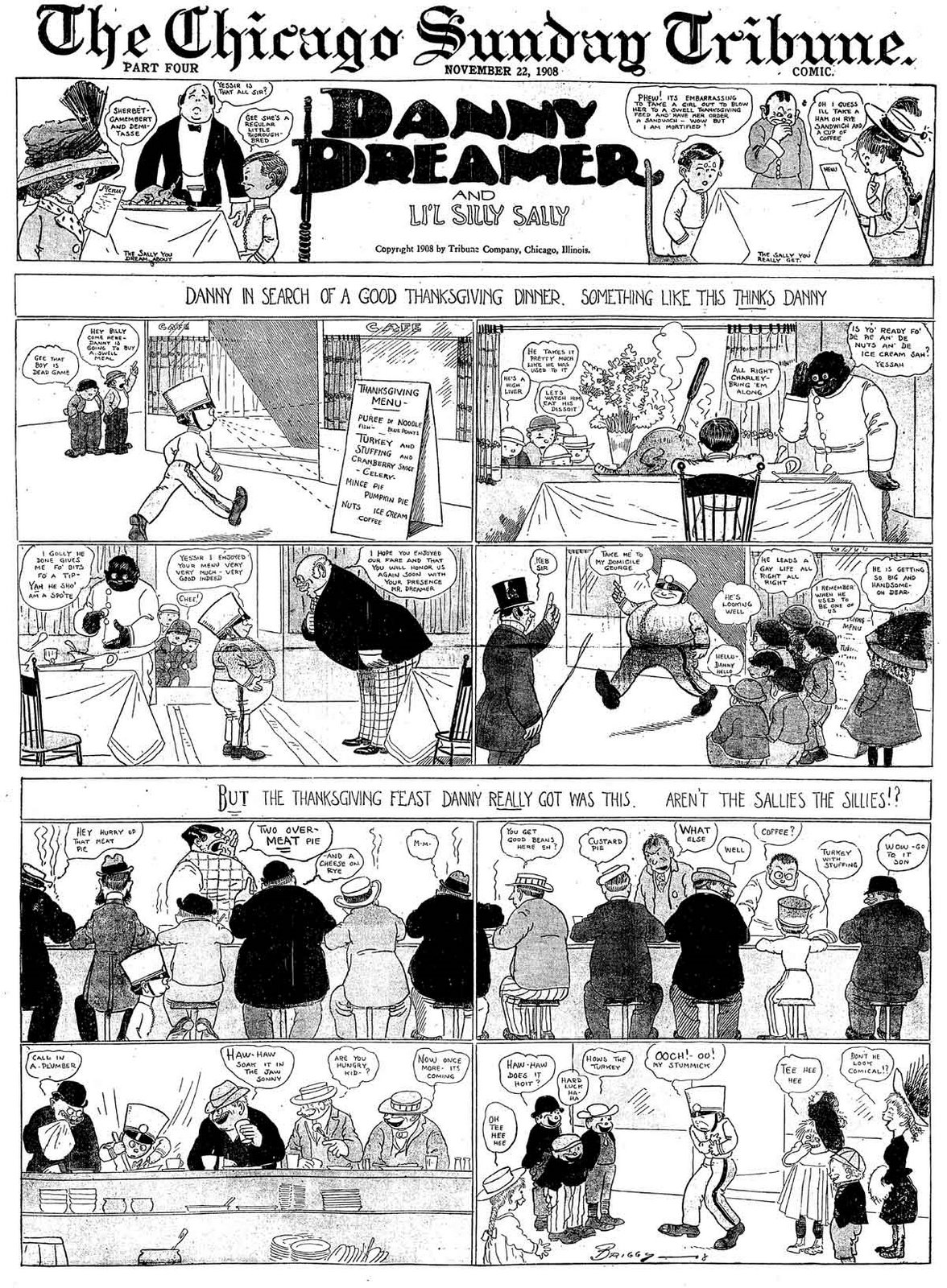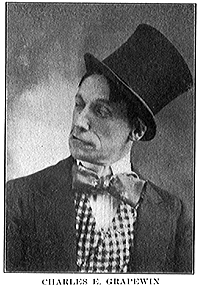|
Clare A. Briggs
Clare A. Briggs (August 5, 1875 – January 3, 1930) was an early American comic strip artist who rose to fame in 1904 with his strip ''A. Piker Clerk''. Briggs was best known for his later comic strips ''When a Feller Needs a Friend'', ''Ain't It a Grand and Glorious Feeling?'', ''The Days of Real Sport'', and ''Mr. and Mrs.'' Early life Born in Reedsburg, Wisconsin, Briggs lived there until the age of nine. In 1884, his family moved to Dixon, Illinois, where he started his newspaper career at age ten, delivering the local paper to subscribers for 40 cents a week while wearing a red, white and blue cap with the name of the newspaper. Briggs had three brothers, who grew up to all have creative careers, one as a musician, one as a writer, and the third in advertising. After five years in Dixon, Briggs was 14 when his family relocated to Lincoln, Nebraska, where he lived until 1896 when he was 21. Life in the Midwest gave Briggs the source material for the small town Americana that ... [...More Info...] [...Related Items...] OR: [Wikipedia] [Google] [Baidu] |
Reedsburg, Wisconsin
Reedsburg is a city in Sauk County, Wisconsin, United States. Its population in 2020 was 9,984. The city is located northwest of Madison, Wisconsin, Madison within the Madison metropolitan area, Baraboo micropolitan area. The city is surrounded by the Reedsburg (town), Wisconsin, Town of Reedsburg and is situated along the Baraboo River. It is the second-largest city in Sauk County after Baraboo, Wisconsin, Baraboo, with a population of 9,984 at the time of the 2020 United States census. Prior to the arrival of non-Indigenous peoples, indigenous people in the 19th century, the region was home to the Ho-Chunk people. Reedsburg was first settled by James W. Babb in 1845. David C. Reed arrived in 1847, building a dam and being the namesake of the town. After the town was Plat, platted in 1852, growth would continue through its incorporation as a city in 1887. Historically, the area has relied on agriculture and manufacturing industries. Reedsburg would grow significantly follow ... [...More Info...] [...Related Items...] OR: [Wikipedia] [Google] [Baidu] |
New York Tribune
The ''New-York Tribune'' (from 1914: ''New York Tribune'') was an American newspaper founded in 1841 by editor Horace Greeley. It bore the moniker ''New-York Daily Tribune'' from 1842 to 1866 before returning to its original name. From the 1840s through the 1860s it was the dominant newspaper first of the American Whig Party, then of the Republican Party. The paper achieved a circulation of approximately 200,000 in the 1850s, making it the largest daily paper in New York City at the time. The ''Tribune''s editorials were widely read, shared, and copied in other city newspapers, helping to shape national opinion. It was one of the first papers in the North to send reporters, correspondents, and illustrators to cover the campaigns of the American Civil War. It continued as an independent daily newspaper until 1924, when it merged with the '' New York Herald''. The resulting '' New York Herald Tribune'' remained in publication until 1966. Among those who served on the paper's ed ... [...More Info...] [...Related Items...] OR: [Wikipedia] [Google] [Baidu] |
Franklin P
Franklin may refer to: People and characters * Franklin (given name), including list of people and characters with the name * Franklin (surname), including list of people and characters with the name * Franklin (class), a member of a historical English social class Places * Franklin (crater), a lunar impact crater * Franklin County (other), in a number of countries * Mount Franklin (other), including Franklin Mountain Australia * Franklin, Tasmania, a township * Division of Franklin, federal electoral division in Tasmania * Division of Franklin (state), state electoral division in Tasmania * Franklin, Australian Capital Territory, a suburb in the Canberra district of Gungahlin * Franklin River, river of Tasmania * Franklin Sound, waterway of Tasmania Canada * District of Franklin, a former district of the Northwest Territories * Franklin, Quebec, a municipality in the Montérégie region * Rural Municipality of Franklin, Manitoba * Franklin, Ma ... [...More Info...] [...Related Items...] OR: [Wikipedia] [Google] [Baidu] |
Johns Hopkins Hospital
Johns Hopkins Hospital (JHH) is the teaching hospital and biomedical research facility of Johns Hopkins School of Medicine in Baltimore, Maryland. Founded in 1889, Johns Hopkins Hospital and its school of medicine are considered to be the founding institutions of modern American medicine and the birthplace of numerous famed medical traditions, including rounds, residents, and house staff. Several medical specialties were founded at the hospital, including neurosurgery by Harvey Cushing and Walter Dandy, cardiac surgery by Alfred Blalock and Vivien Thomas, and child psychiatry by Leo Kanner. Johns Hopkins Children's Center, which serves infants, children, teens, and young adults aged 0–21, is attached to the hospital. Johns Hopkins Hospital is widely regarded as one of the world's greatest hospitals and medical institutions. For 21 consecutive years from 1991 to 2020, it was ranked as the best overall hospital in the United States by ''U.S. News & World Report''. In its 2019–20 ... [...More Info...] [...Related Items...] OR: [Wikipedia] [Google] [Baidu] |
Kin Platt
Kin Platt (December 8, 1911 – November 30, 2003) was an American writer, artist, painter, sculptor, caricaturist, and comics artist, best known for penning radio comedy and animated TV series, as well as children's literature, children's Mystery fiction, mystery novels, one of which earned him the Mystery Writers of America Edgar Award. He additionally wrote and drew comic books (creating an early talking animals in fiction, talking animal superhero, Supermouse) and comic strips. Biography Early life and career Kin Platt was born to Etta (née Hochberg) and Daniel Platt. In the mid-1930s he wrote radio comedy for George Burns, Jack Benny, the comedy team of Stoopnagle and Budd, and ''The National Biscuit Comedy Hour of 1936''. Later in the 1930s, he wrote for Disney and Walter Lantz theatrical cartoons, and he scripted the Robert Benchley film ''How to Read'' (1938). Comic books He broke into comic books with humor stories featuring the character "Happy" in the Nedor, Bette ... [...More Info...] [...Related Items...] OR: [Wikipedia] [Google] [Baidu] |
Frank Fogarty
Frank Fogarty (1887-1978) ''Lambiek's Comiclopedia''. Accessed Dec. 23, 2017. was an American artist, primarily active in the 1930s and 1940s. A native New Yorker, as a teenager Fogarty worked as a at the ''''.O'Hearn, Bradford W. "Former cartoonist, now in his 80s, daily produces medieval masterpieces," ''Biloxi Daily Herald'' (January 28, 1974), p. 12. Editors there pooled their money to send him to the |
Arthur Folwell
Arthur Fitzgerald Folwell (23 September 1904 – 14 October 1966) was a British-born Australian professional rugby league footballer who played in the 1920s, 1930s and 1940s, coached in the 1940s, and was an administrator in the mid-20th century. An Australia national and New South Wales state representative , he played his club football in the New South Wales Rugby Football League for Sydney's Newtown before becoming their coach and taking them to the 1943 NSWRFL premiership. Playing career In 1933 Folwell was selected for the Australian touring squad for the 1933–34 Kangaroo tour of Great Britain . He became Kangaroo No. 179 when played in the 2nd and 3rd Test matches and he played another 19 matches on the 1933-34 tour. Coaching career Folwell coached Newtown for three seasons during the Second World War (1942–1944). He is remembered as the winning grand final coach in 1943, the year Newtown won the 1943 grand final. In Folwell's final year as coach of Newtown he t ... [...More Info...] [...Related Items...] OR: [Wikipedia] [Google] [Baidu] |
New York Herald Tribune Syndicate
The New York Herald Tribune Syndicate was the Print syndication, syndication service of the ''New York Herald Tribune''. Syndicating comic strips and newspaper Column (periodical), columns, it operated from c. 1914 to 1966. The syndicate's most notable strips were ''Mr. and Mrs.'', ''Our Bill'', ''Penny (comic strip), Penny'', ''Miss Peach'', and ''B.C. (comic strip), B.C.'' Syndicated columns included Walter Lippmann's ''Today and Tomorrow'' (c. 1933–1967), Weare Holbrook's ''Soundings'', George Fielding Eliot's military affairs column, and John Crosby (media critic), John Crosby's radio and television column. Irita Bradford Van Doren was book review editor for a time. History The syndicate dates back to at least 1914, when it was part of the ''New York Tribune''. (The ''Tribune'' acquired the ''New York Herald'' in 1924 to form the ''New York Herald Tribune''.) The syndicate's first comic strip of note was Clare Briggs' ''Mr. and Mrs.'', which debuted in 1919. Harry Staton b ... [...More Info...] [...Related Items...] OR: [Wikipedia] [Google] [Baidu] |
Catchphrase
A catchphrase (alternatively spelled catch phrase) is a phrase or expression recognized by its repeated utterance. Such phrases often originate in popular culture and in the arts, and typically spread through word of mouth and a variety of mass media (such as films, internet, literature and publishing, television, and radio). Some become the de facto or literal "trademark" or "signature" of the person or character with whom they originated, and can be instrumental in the typecasting (acting), typecasting of a particular actor. Catchphrases are often humorous, can be (or become) the punch line of a joke, or a callback (comedy), callback reminder of a previous joke. Culture According to Richard Harris, a psychology professor at Kansas State University who studied why people like to cite films in social situations, using film quotes in everyday conversation is similar to telling a joke and a way to form solidarity with others. "People are doing it to feel good about themselves, to m ... [...More Info...] [...Related Items...] OR: [Wikipedia] [Google] [Baidu] |
Paramount Pictures
Paramount Pictures Corporation, commonly known as Paramount Pictures or simply Paramount, is an American film production company, production and Distribution (marketing), distribution company and the flagship namesake subsidiary of Paramount Global. It is the sixth-oldest film studio in the world, the second-oldest film studio in the United States (behind Universal Pictures), and the sole member of the Major film studio, "Big Five" film studios located within the city limits of Los Angeles. In 1916, film producer Adolph Zukor put 24 actors and actresses under contract and honored each with a star on the logo. In 1967, the number of stars was reduced to 22 and their hidden meaning was dropped. In 2014, Paramount Pictures became the first major Hollywood studio to distribute all of its films in digital form only. The company's headquarters and studios are located at 5555 Melrose Avenue, Hollywood, California. The most commercially successful film franchises from Paramount Pictu ... [...More Info...] [...Related Items...] OR: [Wikipedia] [Google] [Baidu] |
Vaudeville
Vaudeville (; ) is a theatrical genre of variety entertainment which began in France in the middle of the 19th century. A ''vaudeville'' was originally a comedy without psychological or moral intentions, based on a comical situation: a dramatic composition or light poetry, interspersed with songs and dances. Vaudeville became popular in the United States and Canada from the early 1880s until the early 1930s, while changing over time. In some ways analogous to music hall from Victorian Britain, a typical North American vaudeville performance was made up of a series of separate, unrelated acts grouped together on a common bill. Types of acts have included popular and classical musicians, singers, dancers, comedians, trained animals, magicians, ventriloquists, strongmen, female and male impersonators, acrobats, clowns, illustrated songs, jugglers, one-act plays or scenes from plays, athletes, lecturing celebrities, minstrels, and films. A vaudeville performer ... [...More Info...] [...Related Items...] OR: [Wikipedia] [Google] [Baidu] |




